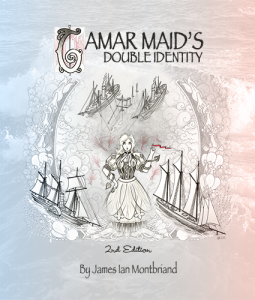The Tamar Maid
The following illustrated short story is based on the true-life events of the steamship and schooner named Tamar Maid. The Tamar Maid ship story and the Tamar biblical story from Genesis 38 closely parallel one another. For the sake of this story, I have tried to match the progress of the two stories. A few things to note about some ‘play on words’ in this story: I use the word taunt and taunting with both the modern meaning and the obsolete meaning of the word. Sailors and mariners would refer to a ship as being too ‘taunt’ if she had masts that were too tall for the ship to support.
The biblical story of Tamar focuses on Tamar obtaining a pregnancy and child (her right to have a child, to ‘give birth’, or simply put, ‘birth-right’). Similar to this biblical story the Tamar Maid story also focuses on her trying to obtain her ‘berth-wright (right)’. I have exchanged the word birth and birth-right for berth and ‘berth-wright’ in the ship’s story. I use the shipbuilding term ‘wright’ to interchange with the word ‘right’. As if ships had their own constitution of rights and freedoms when built. Every ship feels she has the right to sail on the sea to fulfill her existence. In this tale I’m paralleling the use of these words.
Definitions (For the purpose of this story)
Berth-wright: (from the ship’s perspective) The inherent right of every vessel capable of sailing on the open sea to have the opportunity to do so.
Too Taunt: (from the ship’s perspective) To have masts too tall for the ship to properly support. Although providing the ship with additional speed and maneuverability, the ship is more likely to tip over in the wrong wind conditions.
I highly recommend pre-reading Genesis chapter 38 from the Bible for a clearer understanding of this story.
2nd Edition Notes
A few years after writing the Tamar Maid saga, I returned to this story to spruce up the information. Since the time that I wrote the book, I found some additional stories in the newspaper archives about ships having second lives. I thought these stories would be an interesting introduction to the Tamar Maid saga. The one story was from 1894 when a report came from Galveston Texas that the Norwegian barque Elsa Andersen towed in a 50-100 year old derelict containing, among her curiosities, lost treasure. This derelict miraculously resurfaced after some seismic activity off the Faroe Islands. The tale seemed rather far fetched, to say the least, but served as a fantastic example of a ship returning from the sea. The other story I decided to include was more down to earth in the form of the tale of the ship Elizabeth. The Elizabeth after a 36 year career was brought into port for an overall in 1834. She was given new copper plating and other substantial repairs. Just as she was being rigged up for her career, down in the South Seas, a fire devastated the ship. My speculation is that the workers were so heartbroken having fixed up this merchant ship only to have it burnt down, that they decided to rebuild her after the fire. The ship entered a second life with the very deliberate new name of Posthumous. She continued in service for another 19 years after the incident. The Faroe Fetched Tale and the Posthumous Tale seemed good lead-in stories for the Tamar Maid. The Tamar Maid received a second lease on life after sinking due to a piloting error. She quite literally came back from the ship graveyard.
Biblical References in the work
The stories in Genesis 37 and 38 seemed appropriate to link with the Tamar Maid saga. Tamar Maid staking claim to her berth-right (to sail on the open sea) paralleled the story of Tamar in Genesis 38. After the Biblical Tamar did not get her way to have a child she donned a taunting disguise and achieved her birthright. Even the ship story has a strange parallel of the posthumous birth of the captain’s son shortly after he was lost at sea. Decades later, when the son died, there was a reference to him being the son of the captain of the Tamar Maid. All that was every found of the son was his red jacket floating in the water. This was very symbolic of the red string reference in the biblical story of Tamar delivering her twins.
The false report of Joseph’s death at the end of Genesis 37 seemed to be a good link for the beginning of the Tamar Maid saga. When a ship sunk, that was normally the end of her career. In the case of Tamar Maid this was a false report. She went on to have a second career in a different form as a schooner.
Purchase a copy on Amazon
View on Amazon...
Purchase Souvenirs
Nice water bottles, travel mugs, tote bags and t-shirts available with art from this book
Visit Cafepress...



